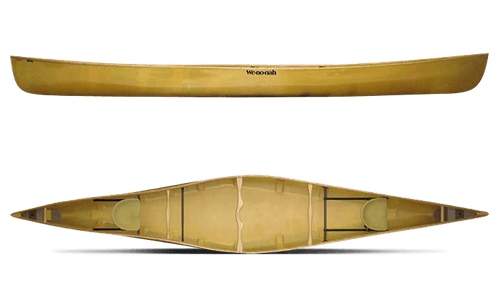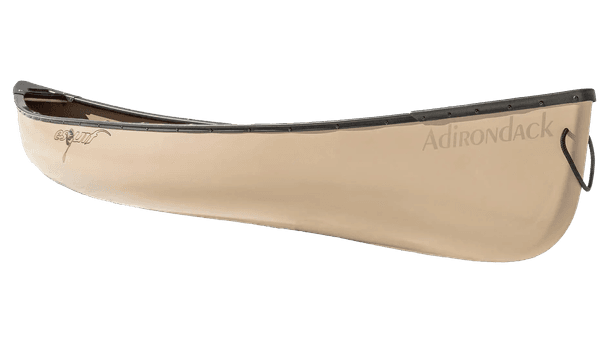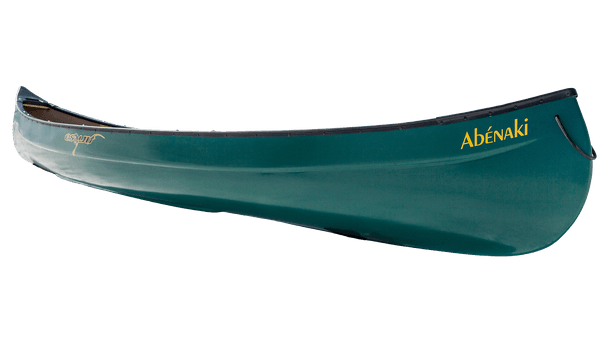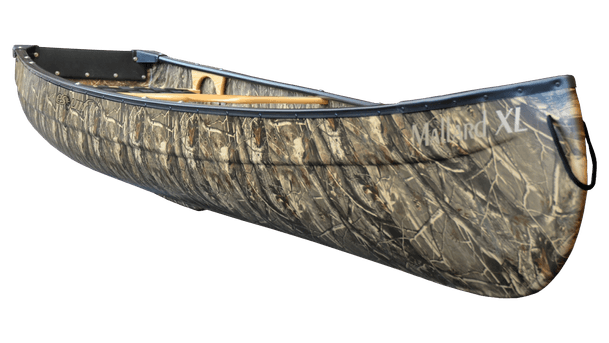- Home
- Gear & Reviews
- Itasca
Itasca

Itasca Options
Itasca Description
The Itasca is a tandem performance touring canoe that's built to carry expedition gear through wind and waves. This long, seaworthy hull tracks superbly, carries loads and glides far. It's the right boat for extreme exploring, coastal touring and week long adventures. The wide midsection of the Itsaca's 19-foot hull allows for big loads, yet makes paddling easy because the sides curve in at the gunwales to allow an easy reach to the water. The standard wood gunwales add strength and beauty to this unique design.
Itasca Specs and Features
- Structure: Rigid / Hard Shell
- Seating Configuration: Solo, Tandem
- Ideal Paddler Size: Average Adult
- Skill Level: Intermediate, Advanced
- Ideal Paddler Size: Average Adult
- Skill Level: Intermediate, Advanced
Wenonah Canoe, Inc.
Itasca Reviews
Read reviews for the Itasca by Wenonah Canoe, Inc. as submitted by your fellow paddlers. All of the reviews are created and written by paddlers like you, so be sure to submit your own review and be part of the community!
People often refer to this…
People often refer to this canoe as a super tanker or an 18 wheeler because it is such a big canoe with such a high volume, while they aren't wrong I don't think that really captures what the Itasca is. The Itasca is better thought of as the monster truck of canoes.
Monster trucks are an outgrowth of offroad racing vehicle design, they aren't designed for racing but they are still fast. Similarly the Itasca's design begins from a Jensen/Wenonah V1-pro racing tandem (notice the similar gunnel lines that allow near vertical paddle strokes), but from there the hull is given a bit of rocker, fattened up, and the bow/stern are flared out and gunnels raised up from the low waterline clearance of a fairweather racer to a truly seaworthy height that provides a massive amount of cargo space.
While the Itasca is easily the most seaworthy canoe I have ever paddled (more in the category of a long sea kayak then a traditional canoe in terms of open water capability) and while it can pack near absurd amounts of cargo, it is still designed around racing lines. The hull is 19'ft long with narrow bow and stern lines that make the Itasca categorically faster than most other paddle boats shorter than 19' ft.... except for exercise/racing hulls that are more nice weather toys rather than a boat you could go on a month long expedition while periodically running over a row of junkyard cars at full speed... Also while the Itasca has a big broad bottom to its hull, unlike most other tripping hulls, it isn't a flat bottom (which provides the maximal FEELING of stability) but rather an enlarged version of a rounded kayak-like bottom to provide better speed and better stability in rough water than a flat bottom.
I paddle this canoe regularly in southern puget sound where there are serious tidal currents, changing winds and complex cross chop from motorboats/wind waves mixing in the swirling currents. I have definitely been out in conditions that have made me as a paddler a bit anxious, but my Itasca isn't even remotely fazed. I have been through some weird, sketchy chop and I don't think a wave has ever gotten over the gunnels. Honestly, I would be terrified to take this thing out in conditions that actually pushed what this boat was capable of.
All this being said, even as an extreme design that attempts to maximize speed/ease of paddling, seaworthiness and cargo capacity the Itasca functions perfectly well as a normal derp-around canoe. A monster truck would be a terrible vehicle to do an everyday run to the grocery store in and here is where my bad metaphor breaks down because the Itasca is just as practical and fun as an easy going day paddler as it is as a once-in-a-lifetime expedition vehicle. The rocker makes the canoe not track quite as well as more traditionally wenonah designs with zero rocker, but it makes maneuvering the 19' length down narrow rivers much easier than it would appear (also, I imagine when you load this thing down with hundreds of pounds of gear you need that rocker to turn at all). In tuf-weave this canoe is only about 70 pounds and it has zero watercanning, the hull is stiff as an arrow unlike say a royalex old town tripper that only gets rigid once you pack it in with gear. The Itasca will catch a lot of wind when it is isn't loaded down with gear, but I have gotten in the habit of bringing a 7 gallon water tank (one of those blue ones people get for car camping) full of water that I put in as ballast when going out into open expanses. Loaded down the wind really doesn't bother the Itasca much and I consider water ballast important in unsettled chop and wind no matter the boat anyways so I don't consider this a flaw. The midsection easily accommodates a 7 gallon water tank with enough room to shift the tank forward/aft which makes dynamically shifting the center of balance of the boat for wind, waves and paddlers of differing size as easy as a quick yank or kick of the tank.
My particular Itasca has adjustable bucket seats forward and aft which is immensely practical and should be standard on all canoes...
If I had to say this canoe has a flaw, it is that while the bow paddling position has WAYYY more space than a narrower canoe such as a Minnesota II (and thus can accommodate a much wider variety of human body types) the gunnels pull in nice and vertical to allow ease of paddling. For a newer paddler in the bow position this can give the feeling that you are stuck wayy out on the end of a narrow stick with a panoramic view of the water around you as if you were strapped to a bowsprit. It can feel a bit exposed to a less experienced paddler in front because you don't have the visual (like the stern paddler does) of a stable 19'ft canoe hull supporting you. As a stern paddler of the Itasca it becomes almost comical how little the hull seems to care about riding over chop and waves and it is easy to terrify the living daylights out of a newbie bow paddler by sending the canoe careening over rough water. This is just a feeling though, there is plenty of space upfront and if the wave the bow was ACTUALLY heading into a wave big enough to crash over the gunnels I would seriously have to wonder what on earth you were doing out in that kind of weather/environment.... Just something to keep in mind.
On the topic of kids, it is worth pointing out that many couples seem to get a pair of single kayaks when they have a kid and then try to figure out a third kayak or a double kayak for a growing kid so they can take them. The Itasca can easily seat a third person in the middle or it can just as happily not. The person in the middle isn't going to be paddling really, but they don't need to, the canoe is fast enough with two paddlers (I mean, it is fast enough with one person paddling 99% of the time really). I think way more families would be happy buying an Itasca and not worrying about how to bring along their kid (or dogs). A grown adult can sit comfortably in the midsection which makes figuring out what to do with an "extra" person so much easier. Bring whatever cargo you feel like, go wild, take the beer coolers from everybody else in your paddling group and throw them in, you get to drink their beer and the canoe just rides better :P.
Ok, one more final note, you can do sick wheelies in this canoe (like a monster truck) by sitting in the bow or stern seat and paddling around in circles while the other end hangs completely out of the water. Not as impressive as a monster truck doing wheelies, but oh well.
All in all unless you are exclusively going down narrow whitewater rivers and streams, I don't see a good argument for going for a shorter, less capable canoe. Conclusion 10/10: a monster truck of a canoe that is still great for everyday paddling.
This is our family tripping…
We (both almost 60 now) have…
Good all-around canoe in my opinion. No, make that a great all-around canoe. The first thing I did after buying it was plug the screw holes in the outwales with exotic wood. All the wood gets varnished about every second year.
What a fantastic canoe! Don't know why Wenonah pigeon-holes it all by itself as an "expedition canoe". Thank-you Gene Jensen for this beauty
Thought it was about time to…
Together my wife & I weigh over 400 lbs, & I stand over 6 feet. My wife, a few inches less. Our kids were raised in the bow of our Moore Venom Racer (nursing while I paddled). We’ve done our minimalist camping, but enjoy good meals & simple frills, so we don’t always pack light. Also, I’m an amateur outdoor photographer, with equipment weighing nearly 100 lbs. on photo ops.
We shopped a long time for our next “Perfect” canoe. It had to have leg room, be big enough for ocean, carry weeks of supplies, track well, and glide like a bird. Eventually we narrowed our search down to 4 different canoes and settled on the Kevlar Flex-Core w/ Gel Coat Itasca. Shortly after, I injured my arm. I was unable to paddle for over a year. I still can’t paddle a double blade, or match the racing strokes I used to love, but as a result, the maiden voyage of the Itasca was more than just a test of my passion…it defined our new canoe.
In high winds, and from the bow, my wife paddled a 9 mi. round trip in one day, & kept up with most of the rest in our group. After I was able to paddle again, we were victims of an intentional swamping prank. We rode quartering waves over 5 ft. from crest to trough & never went over. We did take on a small amount of water & the bow free-fell to the bottom with a slap, but we were still able to assist a flipped kayak suffering the same prank immediately after.
Insight & tips. This is a remarkable canoe. It instantly became our favorite. We ordered it with the Kevlar skid pads. Unlike after market installations, these are installed in the mold prior to laminating. There is NO additional drag. We got sliding/contoured seats, & a rear foot brace. After reading about wind problems, I was going to make a canoe cover. Not possible with my injury, so I called Wenonah. They told me: "Load extra ballast." An old trick we’ve used to trim out canoes for decades. But this required a lot of ballast & was soon abandoned. Our solution was a couple of $35.00 car top bags from Pep Boys. Empty or loaded, these shed the wind like a raincoat to rain, & give us a great & secure way to load the vessel. Speed is unholy for a touring canoe. It will never compete against a true racer, but for a tandem touring canoe it’s heaven.
Maneuvering was supposed to be a problem. After 20+ years in a marathon racer, it was no big deal. We use many of the same strokes the racer needs, & we can turn it on a dime in an instant. And the glide…it has a Gene Jensen glide. Need I say more. To launch, I just shove off & jump in. Initial stability is shamefully similar to a…er…uh…recreational…uh…floatie thing, but the secondary is so good you almost can’t find its limits. Get a light color, it hides the scratches better. Would be nice if Wenonah would offer pre-finished gunwale options for an additional price. It took me weeks to finish ours left handed.
The price was high, but worth it. Are there other great canoes out there? No doubt. So the down side would be this: I’ll probably never have a desire to find out. Feel free to e-mail me if you have any questions. Vern Matthews, keep your bottom wet!
P.S: I rate a canoe or kayak by how well they meet up to their advertised expectations. I won’t rate one based on improper applications (e.g. whitewater use on a recreational canoe, unless it functions well even when not used as intended). So a 10 does an incredible job doing exactly what it was designed to do. If I could, I’d rate this one an 11. I never thought flatwater touring could go to this level!
I've had my Ultra Light…
Itasca, kevelar flex-core in…
My suggestion would be to get slider seats front and rear. Love that seaworthiness.
Love on first try Our first few tandem canoes were of the ordinary…
Our first few tandem canoes were of the ordinary type: fibreglass, heavy, flat bottom with little rocker and not a hint of a tumblehome (what’s that anyway?). We where satisfied. Everybody was using that stuff. So it couldn’t be that bad. And because all our friends and fellow paddlers where using the same kind of canoe, mostly made by the same company, we couldn’t do any comparison. That changed as our local canoe dealer got a hold on a new dealership. An American company, we hadn’t heard of before in Europe:
We-no-nah. Someone joked: We-Know-Nothing… Not true as later found out! I flipped through their catalogue and especially one canoe caught my attention: ITASCA!
I wanted to try that canoe! But of course, it was the most expensive one We-No-Nah made at that time. And of course, our friend and canoe dealer couldn’t afford to stock one. So he phoned around. Found one, three hours away at another dealership. Unfortunately, they wouldn’t allow us a test ride. Not on the phone, though…
A week later my wife and I visited that dealer. We got our test paddle after all…. I was amazed! The gunnels are pulled inwards at both seats. They are parallel to the keel line at the stern with lots of tumblehome. That accounts for highly effective power strokes without much correction: You tend to do your forward strokes parallel to the gunnels- that of course puts you off course with most canoes…
Not that much tumblehome in the bow (but still more than most canoes), due to the flare Gene gave her there. That accounts for dry runs through high waves. She is ‘ocean’ going-although I like to see at least one shoreline close by when I’m paddling…
At 19 feet length, Itasca can’t be a turning wonder. But empty, with paddlers only, she turns surprisingly easy and fast. Laden, it’s another story…. But fast she is-a Gene Jensen design with really sharp entry lines.
We later ordered our first Itasca. The cheapest and heaviest version-71 lbs. Today, my wife and me own our third Itasca. The lightest one they build. 45 lbs-I don’t like long portages but her weight certainly helps. So far, she has taken on any load we placed into her wide belly.
Three weeks worth of provisions, two kids, a 100lbs dog, me and my wife - all at the same time. I love her (both of them, this time…).
If you meet us on the water, feel free to ask for a test ride. But be prepared for love on first try…..
I've had my kevlar…
We had originally test paddled a Minnesota II at a local dealer who recommended the boat to us based on our needs. I had purchased it after paddling it on calm water unloaded with 2 paddlers. We were assured it would be good for our family of 5 + gear. It was a grave error and I contacted We-no-nah who recommended the Itasca. They took the Minnesota back and we bought the Itasca. I can't say enough about We-no-nah's customer service. Finding a manufacturer that stands behind its product is an important buying consideration. If you're looking for a craft capable of large loads, with good speed and predictable manners, then the Itasca is for you.
Some people say that you…
We have the Tuf-Weave version…
We own a kevlar ultra light…
My wife and I wanted a…
I've bought a kevlar foam…
In detail: The foam core makes this canoe really stiff, and the moderate arched bottom together with the sleek lines and the length make it fast. When unloaded and trimmed well (sliding seats for paddlers with different weights), it feels like a cruiser and really glides. Initial stability is good, but secondary stability is fantastic. Paddling ergonomy is very good because of lots of tumblehome at the seats, so paddlers can move their paddle very close to them. When searching for an extra big and stable, but fast and light canoe, the Itasca is one of the most serious choices out there. Most Paddlers here rate their canoes high between 8 and 10, so objectivity might not be given, when paddlers write about their own, with hard earned money buyed canoe. But be sure - the Itasca gets 10 of 10 for the purposes it's made.





